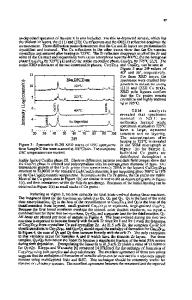Phase transformations in Ti-6.8Mo-4.5Fe-1.5Al
- PDF / 2,398,939 Bytes
- 13 Pages / 612 x 792 pts (letter) Page_size
- 94 Downloads / 351 Views
I.
INTRODUCTION
Stimulus for development of advanced high strength– low density materials has long come from the aerospace industry.[1] In this effort, titanium alloys are of particular interest since they are capable of high specific strengths when compared to competitive materials such as precipitation-hardened stainless steels or aluminum-based alloys. Among titanium alloys, metastable b compositions offer higher specific strengths than either a or a 1 b compositions and possess, in addition, excellent hardenability, cold deformability, and corrosion resistance.[2] Historically, these alloys have, however, seen limited utility because of their relatively high cost when compared to other structural material candidates. Recently, attempts have been made to overcome this disadvantage and, thereby, favor further commercial development of metastable b titanium alloys through the development of a new alloy, designated TIMET LCB (‘‘low-cost beta’’), whose composition, Ti-6.8Mo4.5Fe-1.5Al, takes advantage of low-cost ferro-moly master alloy additions to reduce formulation costs. Since metastable b-titanium alloys are primarily strengthened through precipitation of secondary phases, e.g., a and v, their final mechanical properties are strongly dependent on the type, morphology, size, coherency, and volume fraction of the precipitates resulting from b phase decomposition. For example, precipitation of transition phases, e.g., v, can result in macroscopic embrittlement, whereas precipitation of finely and homogeneously dispersed a generally enhances strength and toughness while maintaining ductility at an acceptable level. As a consequence, the characterization and understanding of precipitation behavior in these systems is of primary importance. S. AZIMZADEH, formerly Graduate Assistant, Department of Ceramic and Materials Engineering, Clemson University, is with GEC-Alsthom, La Rochelle, France. H.J. RACK, Professor, is with the Department of Ceramic and Materials Engineering, Clemson University, Clemson, SC 29634-0921. Manuscript submitted November 11, 1997. METALLURGICAL AND MATERIALS TRANSACTIONS A
The purpose of this investigation was to provide such as understanding for Ti-6.8Mo-4.5Fe-1.5Al. The precipitation reactions occurring in this alloy were investigated considering two aging treatment pathways, isothermal aging and artificial aging following solution treatment and cooling to room temperature. II.
EXPERIMENTAL PROCEDURES
The alloy investigated in this study was received as a solution-treated (954 7C for 2 hours) and water-quenched rolled plate (Table I). Scanning electron microscopy (SEM) (Figure 1(a)) indicated that it had an equiaxed b microstructure with an average grain size of 150 mm. A few particles, identified by energy-dispersive X-ray analysis as P and Si containing inclusions, were also randomly distributed within the alloy.[3] Diffuse intensity streaking in selectedarea transmission electron microscopy diffraction also indicated that the athermal v phase had formed during cooling from the solut
Data Loading...











